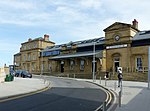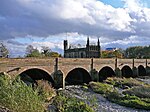Wakefield power station

The Wakefield power stations refers to a series of two coal-fired power stations situated on the River Calder at Agbrigg south east of Wakefield, serving much of West Yorkshire. The first station on the site, Wakefield A power station was constructed for Wakefield Corporation in the late-1880s. A second station, Wakefield B power station, was brought into operation in the late-1940s and was decommissioned in 1991. The power station was situated between the A638 Doncaster Road and the southern bank of the River Calder, just east of the point where the railway line (originally built by the Lancashire and Yorkshire Railway in 1848), from Wakefield Kirkgate to Oakenshaw junction, crosses the navigation.
Excerpt from the Wikipedia article Wakefield power station (License: CC BY-SA 3.0, Authors, Images).Wakefield power station
Park Hill Close, Wakefield Belle Vue
Geographical coordinates (GPS) Address Nearby Places Show on map
Geographical coordinates (GPS)
| Latitude | Longitude |
|---|---|
| N 53.67368 ° | E -1.47355 ° |
Address
Park Hill Close
Park Hill Close
WF1 5GA Wakefield, Belle Vue
England, United Kingdom
Open on Google Maps










